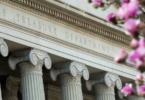DUBAI (Agencies): Saudi banks are entering the New Year from a position of advantage with higher loan growth and relatively low impairments reported in in the first three quarters of 2020.
Despite the challenging operating environment posed by COVID-19 and drastic fall in oil prices, 2020 was not such a bad year for the Saudi Banks, according to Bank of America Merrill Lynch (BoAML) analysts.
The Saudi banks, like others in the Middle East North Africa region, have faced the perfect storm of falling interest rates and a weak and increasingly uncertain economic outlook, with the Saudi economy forecast to shrink 5.6 per cent by the IMF in 2020.
“Yet despite this, the Saudi banks have fared strongly, with system loan growth having reached 11 per cent year to date (and 14 per cent year on year at the close of the third quarter 2020),” said a BoAML note.
Banking sector revenues improved 3 per cent year to date largely by lower cost of funds resulting from 50 billon riyal interest free government deposits. The year saw banks limiting decline earnings despite a 34 per cent spike in impairments largely through cost control measures.
Scope for optimism
BoAML said the Saudi banks are entering 2021 from a position of strength, with tier one capital ratios above 17 per cent on average, non-performing loan (NPL) coverage in excess of 140 per cent and healthy liquidity measures.
Additionally, a stronger economic rebound in 2021 with the IMF projecting 3.6 per cent GDP growth above the GCC average of less than 2 per cent, loan growth is expected to pick up further underpinned by continued strong growth in the mortgage market.
“We see loan growth reaching 9 per cent in 2021, with upside risks. Margin decline is set to abate, with the fourth quarter 2020 likely representing the bottom in net interest margins for the banks,” BoAML said in a note.
Analysts said the extension of Central bank support measures should also be supportive for margins given the cost of funding advantages provided. Additionally cost of risk is set to ease in to 2021and scope for growth in non-interest income streams looks bright.
Lingering risks
Asset quality is an area Saudi banks could face challenges in the near term.
The combined impact of COVID-19 and oil prices has put pressure on asset quality and profitability, and undermined banks’ standalone credit strength according to rating agency Fitch.
“We expect corporate default rates to increase as a result of the pandemic and lower economic activity, although some recovery has been observed since the April lockdown,” said Redmond Ramsdale, an analyst at Fitch.
Although the banks have reported strong loan growth in the first 9 months, largely driven by the consumer and credit card segment, the sustainability of this will depend on job growth.
“The near-term outlook for Saudi banks looks bearish,” said Asad Ahmed, A&M Managing Director and Head of Middle East Financial Services. “The government’s announcement to cut budget spending by 7.5 per cent in 2021 could have a spillover effect in other sections of economy.”
Late NPL reporting
Fitch analysts see delayed recognition of impairments, a tempering of growth and increasing government fiscal consolidation measures as key risks.
The sector’s asset-quality metrics were stable in the first nine months, supported by government forbearance measures and high credit growth. This will likely be undermined by more corporate defaults but also delayed asset-quality problem recognition from the first quarter of 2021 as government support measures expire. Banks have been building provisions since first quarter 2020 in anticipation of weaker asset quality.
Fitch expects credit quality issues will be less severe at retail-focused banks as almost all financing is to public-sector employees and salary-assigned (repayments are deducted directly from the borrower’s salary). However, this safety net will largely depend on there being no lay-offs in the public sector or an escalation in austerity measures.
Margin pressures
Net interest margin (NIM) of Saudi banks continued to decline substantially, reaching 3.02 per cent in the third quarter, the lowest in several quarters.
Cut in interest rates by the Saudi Central Bank (SAMA) has put pressure on margins, in particular for banks with high proportions of non-interest bearing deposits. Low trade volumes and economic activity also undermine fee income generation.
Capital and liquidity
The sector remains well-capitalised, with an average common equity Tier 1 ratio of 17.8 per cent at end of third quarter. This is among the highest globally and is despite high credit growth and loan impairment charges. The sector’s liquidity has been supported by large government deposits since the first quarter.
Sovereign support
Despite changing the outlook of leading banks to negative, Fitch said Saudi Arabia has the ability to support the sector, given its still large, albeit decreasing, external reserves. It also reflects a track record of support for its banks, irrespective of their size, franchise, funding structure and level of government ownership.






